Page 43 of 532
WARNING!
•
If the black latch and black buckle are not prop-
erly connected when the seat belt is used by an
occupant, the seat belt will not be able to provide
proper restraint and will increase the risk of injury
in a collision.
•
When reattaching the black latch and black
buckle, ensure the seat belt webbing is not
twisted. If the webbing is twisted, follow the
preceding procedure to detach the black latch and
black buckle, untwist the webbing, and reattach
the black latch and black buckle.
Inserting Latch Plate
THINGS TO KNOW BEFORE STARTING YOUR VEHICLE 41
2
Page 44 of 532
WARNING!
If the black latch and buckle are not connected when
the seat belt is used by an occupant, the seat belt will
not restrain you properly.
Adjustable Upper Shoulder Belt AnchorageIn the front row outboard seats, the shoulder belt can be
adjusted upward or downward to help position the belt
away from your neck. Press the button located on the
upper belt guide, and then move it up or down to the
position that fits you best.
In-Use Position
Shoulder Belt Adjustment
42 THINGS TO KNOW BEFORE STARTING YOUR VEHICLE
Page 46 of 532
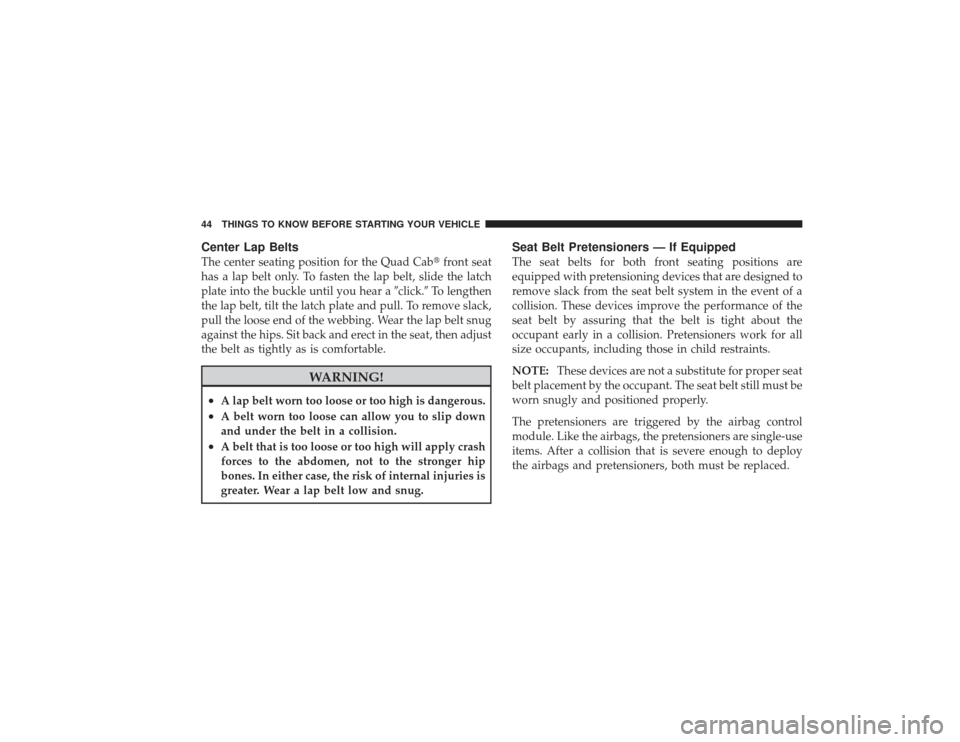
Center Lap BeltsThe center seating position for the Quad Cab�front seat
has a lap belt only. To fasten the lap belt, slide the latch
plate into the buckle until you hear a �click.�To lengthen
the lap belt, tilt the latch plate and pull. To remove slack,
pull the loose end of the webbing. Wear the lap belt snug
against the hips. Sit back and erect in the seat, then adjust
the belt as tightly as is comfortable.
WARNING!
•
A lap belt worn too loose or too high is dangerous.
•
A belt worn too loose can allow you to slip down
and under the belt in a collision.
•
A belt that is too loose or too high will apply crash
forces to the abdomen, not to the stronger hip
bones. In either case, the risk of internal injuries is
greater. Wear a lap belt low and snug.
Seat Belt Pretensioners — If EquippedThe seat belts for both front seating positions are
equipped with pretensioning devices that are designed to
remove slack from the seat belt system in the event of a
collision. These devices improve the performance of the
seat belt by assuring that the belt is tight about the
occupant early in a collision. Pretensioners work for all
size occupants, including those in child restraints.
NOTE: These devices are not a substitute for proper seat
belt placement by the occupant. The seat belt still must be
worn snugly and positioned properly.
The pretensioners are triggered by the airbag control
module. Like the airbags, the pretensioners are single-use
items. After a collision that is severe enough to deploy
the airbags and pretensioners, both must be replaced.
44 THINGS TO KNOW BEFORE STARTING YOUR VEHICLE
Page 48 of 532
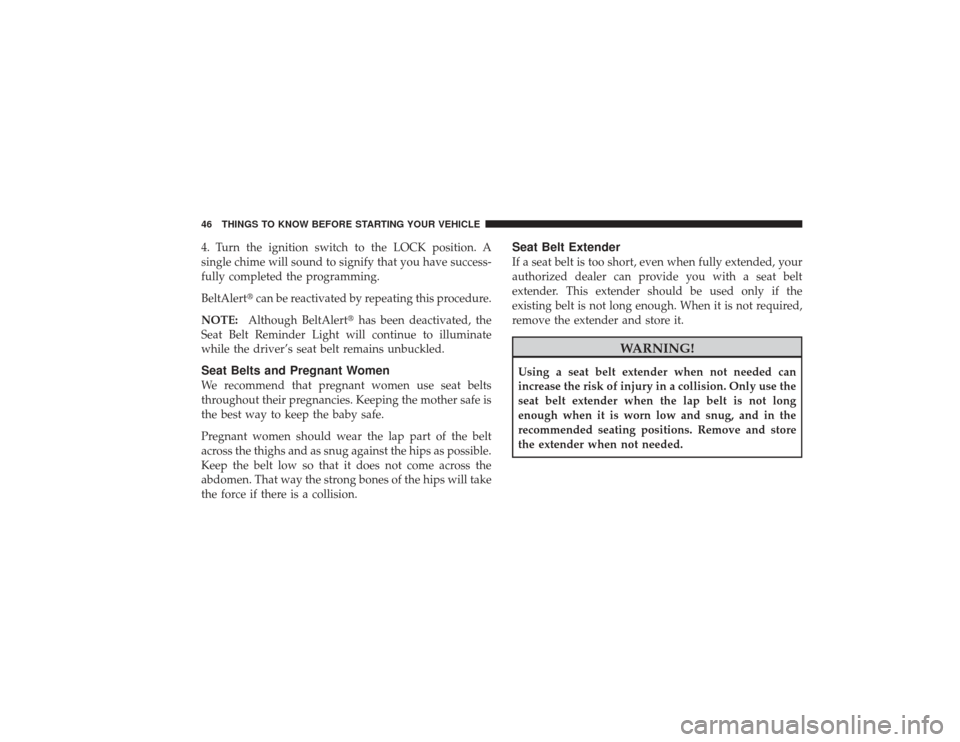
4. Turn the ignition switch to the LOCK position. A
single chime will sound to signify that you have success-
fully completed the programming.
BeltAlert�can be reactivated by repeating this procedure.
NOTE: Although BeltAlert� has been deactivated, the
Seat Belt Reminder Light will continue to illuminate
while the driver’s seat belt remains unbuckled.Seat Belts and Pregnant WomenWe recommend that pregnant women use seat belts
throughout their pregnancies. Keeping the mother safe is
the best way to keep the baby safe.
Pregnant women should wear the lap part of the belt
across the thighs and as snug against the hips as possible.
Keep the belt low so that it does not come across the
abdomen. That way the strong bones of the hips will take
the force if there is a collision.
Seat Belt ExtenderIf a seat belt is too short, even when fully extended, your
authorized dealer can provide you with a seat belt
extender. This extender should be used only if the
existing belt is not long enough. When it is not required,
remove the extender and store it.
WARNING!
Using a seat belt extender when not needed can
increase the risk of injury in a collision. Only use the
seat belt extender when the lap belt is not long
enough when it is worn low and snug, and in the
recommended seating positions. Remove and store
the extender when not needed.
46 THINGS TO KNOW BEFORE STARTING YOUR VEHICLE
Page 50 of 532
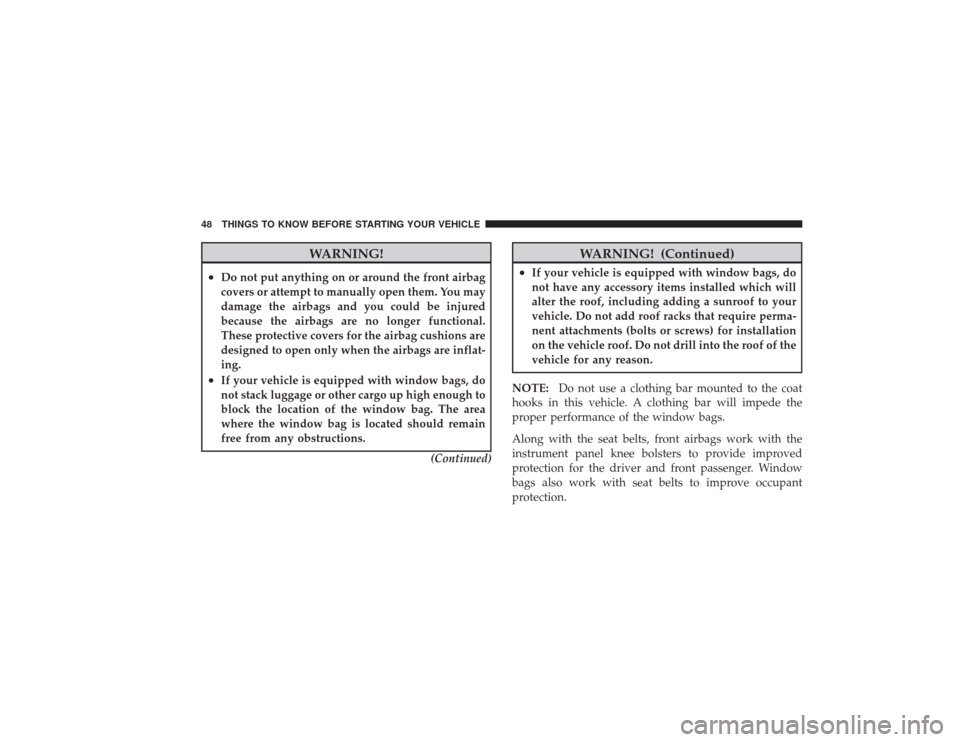
WARNING!
•
Do not put anything on or around the front airbag
covers or attempt to manually open them. You may
damage the airbags and you could be injured
because the airbags are no longer functional.
These protective covers for the airbag cushions are
designed to open only when the airbags are inflat-
ing.
•
If your vehicle is equipped with window bags, do
not stack luggage or other cargo up high enough to
block the location of the window bag. The area
where the window bag is located should remain
free from any obstructions.(Continued)
WARNING! (Continued)
•
If your vehicle is equipped with window bags, do
not have any accessory items installed which will
alter the roof, including adding a sunroof to your
vehicle. Do not add roof racks that require perma-
nent attachments (bolts or screws) for installation
on the vehicle roof. Do not drill into the roof of the
vehicle for any reason.
NOTE: Do not use a clothing bar mounted to the coat
hooks in this vehicle. A clothing bar will impede the
proper performance of the window bags.
Along with the seat belts, front airbags work with the
instrument panel knee bolsters to provide improved
protection for the driver and front passenger. Window
bags also work with seat belts to improve occupant
protection.
48 THINGS TO KNOW BEFORE STARTING YOUR VEHICLE
Page 51 of 532
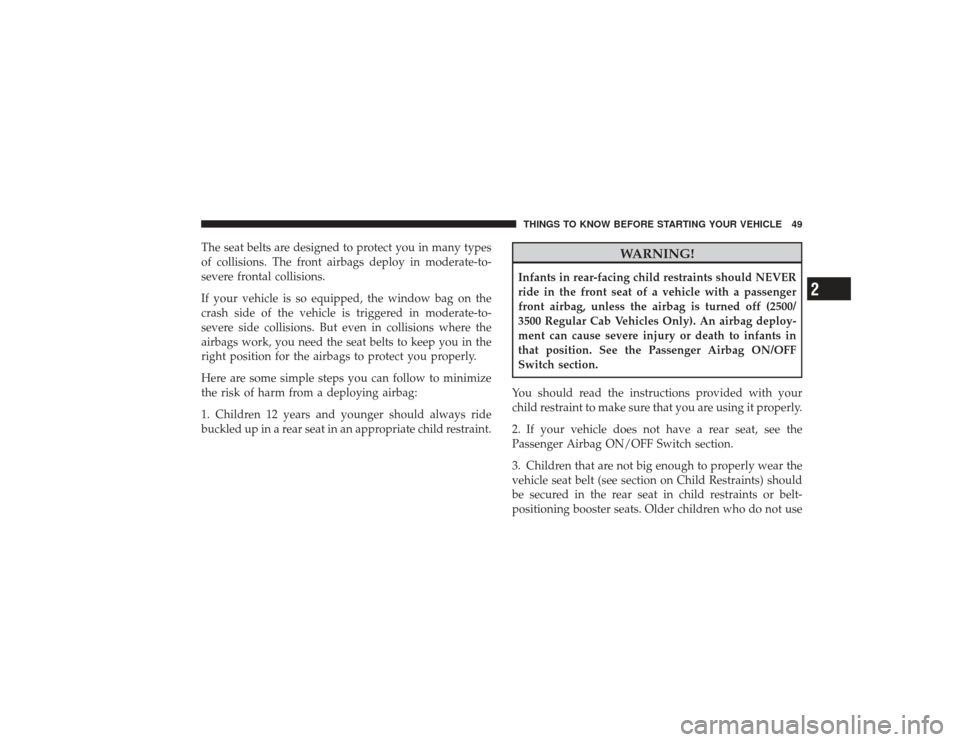
The seat belts are designed to protect you in many types
of collisions. The front airbags deploy in moderate-to-
severe frontal collisions.
If your vehicle is so equipped, the window bag on the
crash side of the vehicle is triggered in moderate-to-
severe side collisions. But even in collisions where the
airbags work, you need the seat belts to keep you in the
right position for the airbags to protect you properly.
Here are some simple steps you can follow to minimize
the risk of harm from a deploying airbag:
1. Children 12 years and younger should always ride
buckled up in a rear seat in an appropriate child restraint.
WARNING!
Infants in rear-facing child restraints should NEVER
ride in the front seat of a vehicle with a passenger
front airbag, unless the airbag is turned off (2500/
3500 Regular Cab Vehicles Only). An airbag deploy-
ment can cause severe injury or death to infants in
that position. See the Passenger Airbag ON/OFF
Switch section.
You should read the instructions provided with your
child restraint to make sure that you are using it properly.
2. If your vehicle does not have a rear seat, see the
Passenger Airbag ON/OFF Switch section.
3. Children that are not big enough to properly wear the
vehicle seat belt (see section on Child Restraints) should
be secured in the rear seat in child restraints or belt-
positioning booster seats. Older children who do not useTHINGS TO KNOW BEFORE STARTING YOUR VEHICLE 49
2
Page 52 of 532
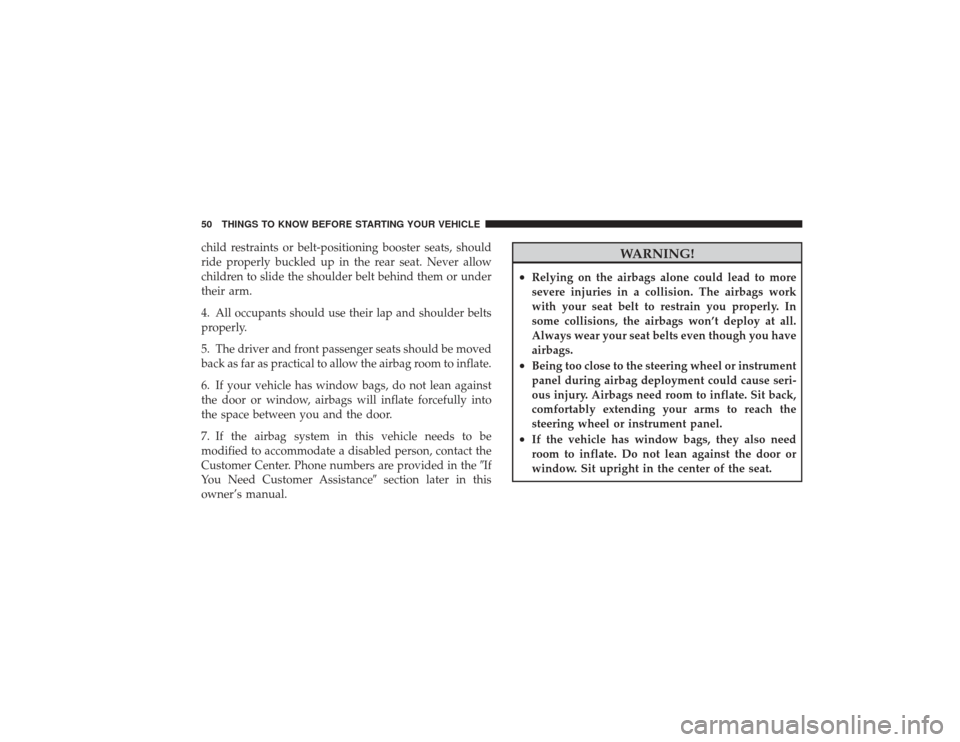
child restraints or belt-positioning booster seats, should
ride properly buckled up in the rear seat. Never allow
children to slide the shoulder belt behind them or under
their arm.
4. All occupants should use their lap and shoulder belts
properly.
5. The driver and front passenger seats should be moved
back as far as practical to allow the airbag room to inflate.
6. If your vehicle has window bags, do not lean against
the door or window, airbags will inflate forcefully into
the space between you and the door.
7. If the airbag system in this vehicle needs to be
modified to accommodate a disabled person, contact the
Customer Center. Phone numbers are provided in the�If
You Need Customer Assistance� section later in this
owner’s manual.
WARNING!
•
Relying on the airbags alone could lead to more
severe injuries in a collision. The airbags work
with your seat belt to restrain you properly. In
some collisions, the airbags won’t deploy at all.
Always wear your seat belts even though you have
airbags.
•
Being too close to the steering wheel or instrument
panel during airbag deployment could cause seri-
ous injury. Airbags need room to inflate. Sit back,
comfortably extending your arms to reach the
steering wheel or instrument panel.
•
If the vehicle has window bags, they also need
room to inflate. Do not lean against the door or
window. Sit upright in the center of the seat.
50 THINGS TO KNOW BEFORE STARTING YOUR VEHICLE
Page 53 of 532

Airbag System ComponentsThe airbag system consists of the following:•
Occupant Restraint Controller (ORC)
•
Side Remote Acceleration Sensors (if equipped)
•
Airbag Warning Light
•
Driver Airbag
•
Passenger Airbag
•
Window Bags above Side Windows (if equipped)
•
Steering Wheel and Column
•
Instrument Panel
•
Interconnecting Wiring
•
Knee Impact Bolsters
•
Front Acceleration Sensors (1500 Vehicles Only)
•
Driver and Front Passenger Seat Belt Pretensioners (if
equipped)
•
Driver Seat Track Position Sensor (if equipped)
•
Passenger Side Frontal Airbag ON/OFF Switch (2500/
3500 Regular Cab Vehicles Only)
•
Passenger Airbag Disable (PAD) Indicator Light
(2500/3500 Regular Cab Vehicles Only)
How the Airbag System Works
•
TheOccupant Restraint Controller (ORC) determines
if a frontal collision is severe enough to require the
airbags to inflate. The front airbag inflators are de-
signed to provide different rates of airbag inflation
from information provided by the ORC. The ORC will
not detect rollover or rear collisions.
The ORC also monitors the readiness of the electronic
parts of the system whenever the ignition switch is inTHINGS TO KNOW BEFORE STARTING YOUR VEHICLE 51
2